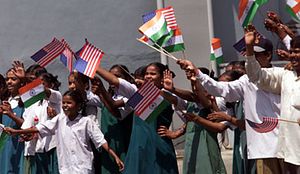As a student in the mid 1960s, I was in India as the cold night of strategic estrangement between the U.S. and India began to fall. Three fundamental factors produced this night: the Cold War, including the U.S. becoming allies with Pakistan for purposes of that war and a division of opinion about Vietnam; the License Raj, or command economy of India; and the nuclear issue, or what some in India called “nuclear apartheid.”
In 1991, the importance of the first two factors was radically reduced. The Soviet Union disintegrated and India instituted economic reforms. With these developments the dawn broke. The relationship seemed to be on a straight upward track.
In January 1998, President Bill Clinton’s National Security Advisor, my friend Sandy Berger, sent me a letter indicating that the White House was prepared to move forward with a presidential trip to India that year.
However, the initial success of reconciliation had induced a sort of slumber that obscured the importance of the nuclear factor in producing estrangement between the U.S. and India.
Few in the United States government or policymaking establishment realized just how deep and emotional the nuclear issue was to India and, particularly, to its defense and policy communities. India wanted to be recognized as equal to the United Kingdom, its imperial oppressor; equal to the United States, which many felt was a successor to Britain in its imperial ambitions; and equal to China, which had invaded India in 1962. The nuclear issue was as much about equality, dignity, respect, and trust as it was about security.
The 1998 nuclear tests awakened the U.S. to the fundamental strength of the nuclear issue as a barrier to the United States and India moving from estrangement to partnership.
The first reactions in the Congress to India’s nuclear tests were supportive of sanctions. On the second day of the tests, May 13, 1998, the Chairman of the Senate Foreign Relations Committee, Senator Jesse Helms (R-NC) interrupted a meeting of the Subcommittee on Near Eastern and South Asian Affairs to castigate India and proclaim “the Indian Government has not shot itself in the foot. Most likely it shot itself in the head.”
However, by the end of 1999 civilian Glenn Amendment sanctions were gone, by the end of 2001 defense sanctions were abolished for all practical purposes, and by the end of 2008 the U.S. had basically recognized India as a legitimate civilian nuclear power and de facto as a military nuclear power. Now the U.S. considers India a “major strategic partner” and security ties are increasing at an exponential rate.
What happened and how did this remarkable change come about?
From the perspective of persuading the U.S. Congress to act, the answer is advocacy by a coalition of business and Indian-American interests aided by the Washington policy or “think tank” community.
A first task was to turn around the Chairman of the Foreign Relations Committee Senator Jesse Helms. His acquiescence was obtained chiefly by an Indian-American community lobbying effort led by Swadesh Chatterjee of North Carolina working with the Government of India.
Equally important was to produce legislation to actually roll back sanctions. The Foreign Relations Subcommittee into which Jesse Helms stormed on May 13, 1998, was chaired by Senator Sam Brownback, Republican of Kansas. Senator Brownback was dedicated to protecting the exports from Kansas, and he took up the mantle of disbanding the sanctions against India.
Kansas means wheat. Thus, the immediate relief from Glenn Amendment sanctions took place in regard to U.S. Department of Agriculture-backed financial support for agricultural exports. But the most important export from Kansas is actually related to the aerospace industry. The industry provided strong backing for legislation known as Brownback I in October 1998 and Brownback II in October 1999. These measures gave waiver authority to the President, and Clinton exercised the waiver authority as soon as it passed.
Also in 1999, the Talbot-Singh talks had produced nothing; India had acted in a cooperative and restrained manner in resolving the Kargil incursion crisis; and the Comprehensive Test Ban Treaty was defeated in the Senate. President Clinton was finished with treating India as anything but a friend. In March 2000, his trip to India showed that the U.S. viewed India not only as a friend but a nascent security partner.
History intervened on September 11, 2001. The U.S. wanted India’s and Pakistan’s help. Remaining defense sanctions were removed.
In 2005, George W. Bush seized the opportunity to remove the nuclear issue as a barrier to U.S.-India strategic cooperation. The coalition between Indian-Americans and U.S. businesses interested in India with the support of the policy community was made formal as the Coalition for Partnership with India. The effectiveness of this coalition resulted in getting the civil nuclear deal through the Congress and signed into law on October 8, 2008. The era of estrangement was over.
There are reasons to believe that the U.S.-India security partnership can continue on a steep upward trajectory: First, the U.S. and India are on the same side in facing the rise of an increasingly aggressive China and the challenge of international terrorism. Second, the largest economy on a nominal or exchange basis and the fastest growing, third largest on a purchasing power basis will continue to be drawn together strategically by common economic interests. Finally, the security partnership continues to be influenced by shared values and Indian American community provides a ready conduit for sharing these values.
The price of continued progress in the U.S.-India partnership is eternal vigilance and care for the relationship. The United States and India are similar, but far too different to assume anything. We must constantly address the impediments that divide us and seize the opportunities that unite us.
Raymond E. Vickery, Jr., is a senior associate at the Center for Strategic and International Studies, a senior advisor at Albright Stonebridge Group, and a former U.S. Assistant Secretary of Commerce, Trade Development.

































